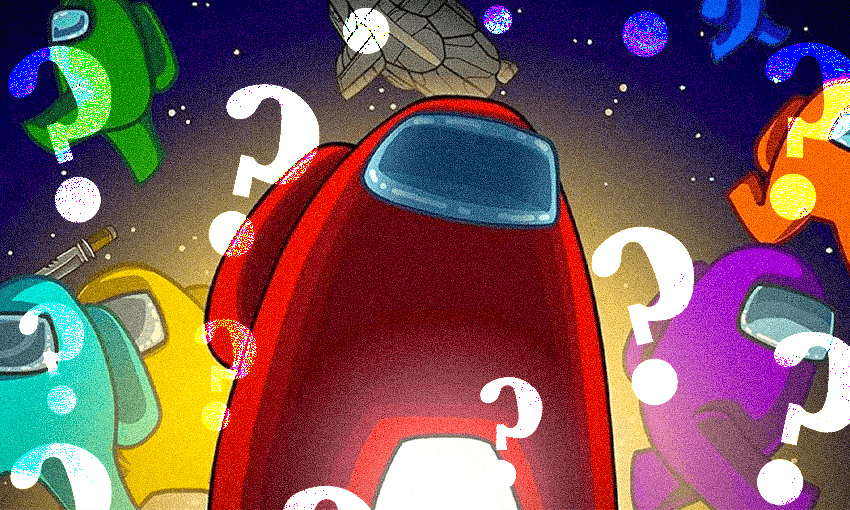It’s the third most streamed game in the world, but what the hell is it? Sam Brooks dives into the world and the many, many memes of Among Us.
So what the hell is Among Us?
The party game Mafia, but with aliens, basically.
Among Us is a multiplayer game for four to 10 players, and it’s played locally or online. One to three players are chosen to be The Impostor each round, while the rest are Crewmates. The action takes place on board a spaceship travelling through one of three space-themed maps.
And what do you actually do?
At the start of each game, Crewmates are given “tasks” (mini-games) to complete around the map, while Impostors are given a list of fake tasks to blend in with the Crewmates. The Impostors work with each other to sabotage the ship and even kill other Crewmates (don’t worry though, the graphics are cutesy and silly – this is not a violent game). If a player dies, Impostor or Crewmate, they become a Ghost. Ghosts must still complete their tasks, in a kind of horrifying metaphor for the role of the worker in a capitalist society.
Crewmates win by completing all tasks or by eliminating all the Impostors. Impostors win when the number of Impostors is equal to the number of Crewmates or when a sabotage countdown reaches zero. A sabotage countdown is what happens when an Impostor performs a sabotage on the map, and the Crewmates have to resolve it. If the countdown reaches zero, the Impostor wins.
But in short, it’s Mafia, but played online with strangers, and much less likely to create severe emotional rifts in your close friendships. Here’s a clip of some gameplay:
Why am I hearing about it now?
Among Us has actually been around for nearly two years, but has had a huge surge in popularity over the past few months. The game became so popular that its developer, InnerSloth, canned a sequel so it could work on improving the current game.
As of this writing, Among Us is the third most played game on Steam, the third most streamed game on Twitch, and has been downloaded more than 90 million times.
The game’s second wave of popularity came from streamers – video game personalities who livestream their play – in Brazil and South Korea, where the game is hugely popular, followed by mega-celebrity streamers like Sodapoppin, Shroud, Ninja and PewDiePie. If you don’t know who those people are already, you don’t need to.
How does AOC fit into all this?
The game got another huge boost after US politicians Alexandria Ocasio-Cortez and Ilhan Omar streamed the game last month on Twitch. Part of a pre-election voter outreach effort, at its peak the livestream drew 439,000 concurrent viewers, making it the third-highest-viewed stream in Twitch history (Among Us has a thing for third place, apparently).
It’s also been streamed by the US Navy esports team, a thing that actually exists, who included references to the N-word and the bombing of Nagasaki in their player names. So that’s fun.
As with many of 2020’s biggest online-facing games, like Fall Guys and Animal Crossing, Among Us has benefited hugely from Covid-19. All of these games allow players a degree of social interaction (we’ll get to that soon) while also offering a distraction from the endless slog that is 2020.
What about the memes?
There are many, many memes that derive from Among Us, which is another reason why you’re hearing about it. There are literally thousands, but this is my favourite:
https://twitter.com/Jasssiex/status/1308556232584761344
Do I need to be concerned that my kid is playing it?
The short answer: Yes, but only as much as any other online game.
The long answer: In Among Us, players communicate with each other via text chat, and match-ups can be randomised – which means your child could end up playing (and chatting) with strangers. Randomised games in general can be quite the shitshow – you can end up playing with saints and sinners alike, or even worse, poor sports who quit the game when it’s not going their way.
On the other hand, if your kid is just playing with their friends, there’s little to worry about.
In terms of whether the gameplay is appropriate for children, that’s up to you and your kid. My take is that it’s probably complex enough to keep them interested, but not so much that they’d be overwhelmed. While the game encourages strategic thinking, keen young players aren’t going to be launching a household coup anytime soon.
How much will it cost me?
Among Us is free on iOS and Android, and costs $6.29 on Steam. As games go, that’s pretty cheap! (The free mobile version has ads though, and they’re reportedly pretty annoying. They can be turned off for a nominal fee.)
In-app purchases are also available, but these are entirely cosmetic, offering players the chance to change spacesuit colours, skins, hats, and other things that don’t affect the gameplay. These in-app purchases give you no in-game advantages – if your kid is telling you they do, they’re straight up lying to you.
Why is my kid obsessed with it?
Bright colours, repetitive/addictive gameplay, the fact that you don’t understand what it is – all are contributing factors. Also, it’s just quite fun!
Will it turn my kid into a dickhead?
Unless your kid already has dickhead tendencies, no, you’re good.
Among Us is, in essence, a party game. While none of us is at our best during party games, they don’t tend to cause any lasting psychological damage. And hey, no kid is going to get the metal shoe from Monopoly biffed at them while playing Among Us.
Among Us is available on Steam, iOs and Android.



